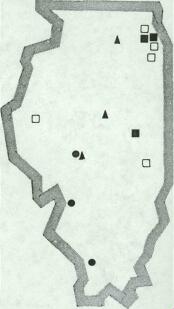
By BOYD R. KEENAN
Should the governance system of Illinois higher education be changed? At stake is the very existence of the five governing boards coordinated by the BHE
General Assembly accepted the basic Kerner idea and created the BHE later in 1961. At that time, the major management components of the State's knowledge industry were: (1) the University of Illinois Board of Trustees, governing the main campus in UrbanaChampaign and a medical center and two-year undergraduate division in Chicago; (2) the Southern Illinois University (SIU) Board of Trustees, governing the main campus in Carbondale and centers in East St. Louis and Alton; (3) a Teachers College Board, with jurisdiction over those institutions now bearing the "university" names of Eastern Illinois at Charleston, Western Illinois at Macomb, Northern Illinois at DeKalb, and Illinois State at Normal; and (4) the Chicago Board of Education, with authority for governing two campuses of the Chicago Teachers College and several junior college campuses. Several other junior colleges, under the management of local school boards, were also located around the State.
Community college system
The charges that Illinois now runs a crazy-quilt system of post-secondary education are largely the result of changes to the system incorporated in the several phases of the State's "Master Plan" for higher education. Immediately following its creation in 1961. the BHE launched Phase 1 of the Master Plan under the leadership of BHE Chairman Ben Heineman, Chicago businessman, and Executive Director Richard Browne, long-time Illinois educator. Recommendations arising from that phase of the plan — Finally approved by the BHE in 1964 — resulted in the legislative creation of a state-wide junior or community college system, coordinated by a new state Junior college agency, now renamed the Illinois Community College Board.
Following this initial phase of the
Master Plan, the General Assembly
also transferred the Chicago Teachers
College to the State Teachers College
Board for management purposes and
created a new local board to govern the
junior colleges in Chicago. Also called
for in Phase I was the development of
new commuter universities in the
Chicago and East St. Louis areas. Funding through bond issues permitted the
University of Illinois to open a fullfledged Chicago Circle Campus near its
Medical Campus and allowed SIU to
open a large campus in Edwardsville,
near East St. Louis, consolidating its
various centers in that area.
Senior institutions in Phase II
Phase II of the BHE Master Plan
called for still other new campuses, and
the General Assembly complied with
the BHE urgings and established
Sangamon State University in
Springfield and Governors State
University in Park Forest. Both were
designed as "senior" institutions, offering junior, senior and first-year
graduate work. Under the BHE's
blueprint, the "senior" institutions served also as commuter schools, receiving
many of their students from community
colleges in their respective areas.
This unprecedented growth in the Illinois knowledge industry was accompanied by a political controversy regarding control of the new institutions. The U. of I. made no secret of its desire to obtain governance authority over the new Springfield and Park Forest campuses. After involved debate sprinkled with acrimony, the BHE chose to recommend to the General Assembly that both new "senior" institutions be assigned for management purposes to governing boards other than the U. of I. Board of Trustees. The General Assembly accepted the BHE recommendation and created a new governance arrangement for Illinois
University of Illinois Campuses • Southern Illinois University Campuses • Regency University Campuses Board of Governors Campuses

Not shown are the U. of I. 's three regional medical school campuses at Peoria, Rockford and Urbana-Champaign.
BOYD R. KEENAN
Holds professorships in both the U. of I. Institute of Government and Public Affairs and Department of Political Science, Chicago Circle Campus. He has served on Illinois state commissions and advisory bodies on higher education, natural resources and energy affairs.
Illinois Issues/January 1975/5